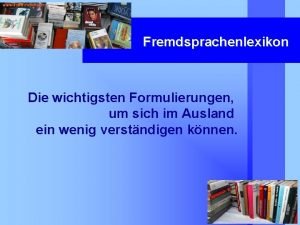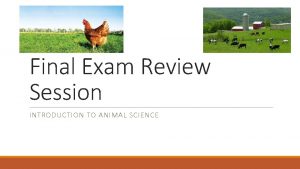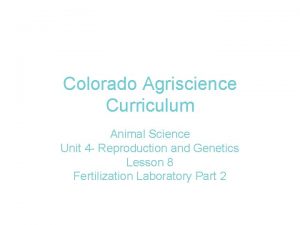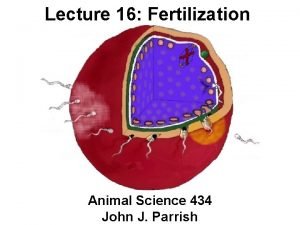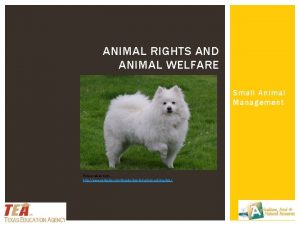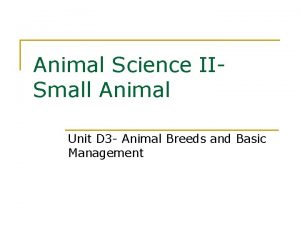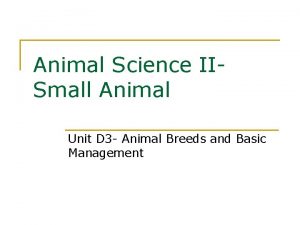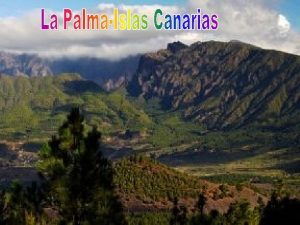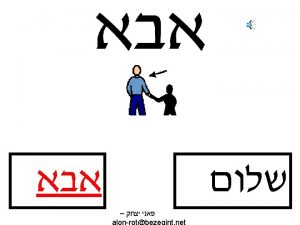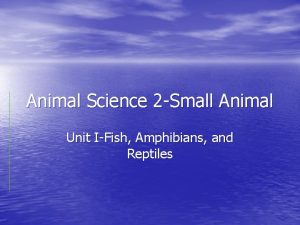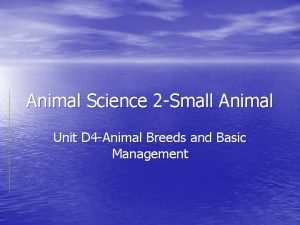Ag Ed Net com SMALL ANIMAL SCIENCE SA











- Slides: 11

Ag. Ed. Net. com SMALL ANIMAL SCIENCE SA 114 Gerbil Types, Housing and Equipment This presentation was produced and is copyrighted by Stewart-Peterson® Inc. 2005. Permission is granted for use by active Ag. Ed. Net. com® subscribers. All other use is prohibited. STEWART-PETERSON and AGEDNET. COM are registered trademarks of Stewart-Peterson Inc.

MAIN IDEA: ØWhat is the most common type of gerbil and what are the basic housing and equipment requirements for gerbils?

Classification: Ø Mongolian gerbil (Meriones unguiculatus) • A mammal belonging to the order of the Rodentia (rodents) • Family of Cricetidae • Most known gerbil species • Especially suitable as a pet. Ø Gerbils are most related to hamsters. Ø Many species are found in Asia and Africa, especially in arid, barren and sandy steppe areas.

More about these desert animals … Ø Very good hearing Ø Conserve body water and can store water in fat cell layers. Ø Little urine and dry feces mean they hardly smell

Description … Ø Body length 5” (12 cm. ) + a tail 2. 5 -5” (6 -12 cm. ) Ø Males somewhat bigger than females, weighing 1. 8 -4. 7 oz. (52 to 133 grams). Ø Slender body, tight skin Ø Short, broad head and pointed nose. Ø Small, fur-covered ears Photo courtesy Ambleside Primary School.

Grouped by coat colors and patterns, not breeds … Ø Agouti – original color of the Mongolian gerbil • Hairs on the back have a grey base, a yellow center band black tips. • Belly and paws are beige or white. • Claws are black. Ø Other colors and coat patterns have been produced through mutations and selective breeding.

Housing: Ø Best cage is an aquarium or terrarium with a solid wire lid. Ø Solid sides are best or gerbils will kick out the bedding material while digging. Ø Housing suitable for hamsters will work well for gerbils. Ø Glass is easy to clean and gerbils can be observed. Ø Height should be at least 12” – gerbils jump well!

Inside the cage: Ø A place to sleep and nest Ø A branch to climb and gnaw on Ø A stone for a lookout Ø Absorbent bedding material – not cedar or pine shavings. Ø Material like burlap for nesting Photo courtesy Ambleside Primary School.

Water and feeding equipment: Ø Water bottle should be hanging type Ø Food bowl is not needed, since gerbils spread their food around the cage Photo courtesy Ambleside Primary School.

And for fun … Ø Gerbils like to burrow, so cardboard tubes or PVC pipes in the cage can imitate the tunnels where gerbils live in the wild. Ø Gerbils also enjoy an exercise wheel.

Ag. Ed. Net. com SMALL ANIMAL SCIENCE www. agednet. com 800 -236 -7862 This presentation was produced and is copyrighted by Stewart-Peterson® Inc. 2005. Permission is granted for use by active Ag. Ed. Net. com® subscribers. All other use is prohibited. STEWART-PETERSON and AGEDNET. COM are registered trademarks of Stewart-Peterson Inc.
 Bài thơ mẹ đi làm từ sáng sớm
Bài thơ mẹ đi làm từ sáng sớm Cơm
Cơm My favourite subject
My favourite subject Venn diagram of plant and animal cell
Venn diagram of plant and animal cell Similarities between plant and animal cells venn diagram
Similarities between plant and animal cells venn diagram Animal rights versus animal welfare
Animal rights versus animal welfare Achmed lach net
Achmed lach net Ado.net vb.net
Ado.net vb.net Life science grade 11 animal nutrition
Life science grade 11 animal nutrition Animal science final exam
Animal science final exam Colorado animal science curriculum
Colorado animal science curriculum J
J






